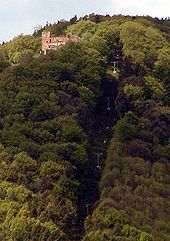Riet (noble family)
The sex of Riet counted in the Middle Ages to the lower nobility in what is now Pfalz (State Rheinland-Pfalz ). His representatives were initially feudal men of the Benedictine Abbey of Weißenburg in northern Alsace , later ministerials and feudal men of the then Hohenstaufen German rulers. Two became known through the construction of the Rietburg or through a political hostage-taking .
Origin of gender
The family came from the area between Speyer and Germersheim and got its name from an area of origin on the Rhine overgrown with reeds . Possibly it was the later Rheinschanzinsel , which at that time lay as a peninsula in a wide loop of the river ; It became an island when the Rhine was straightened out in the 19th century, has belonged to Baden since then and has housed the Philippsburg nuclear power plant since the 1970s . The von Riet family was first mentioned in 1149 in a document from the southern Palatinate monastery of Eusserthal .
Construction of the Rietburg
The construction of the Rietburg (between 1200 and 1204) near the small town of Edenkoben in the south of the Palatinate is attributed to the Lords of Riet . The builder of the castle was Konrad II von Riet , the eldest of six sons of the father Konrad I and his wife Adelheid, who had been married since 1184.
Political hostage-taking
After the death of Konrad II, his cousin Hermann von Riet took over the rule of the castle. In the conflicts between the Staufers and Guelphs that flared up after 1250 , he remained a Hohenstaufen henchman. In 1255 he arrested Queen Elisabeth , wife of the German King Wilhelm , who belonged to the Guelphs , and her companion during a trip from the episcopal city of Worms to Trifels Castle near the local community of Edesheim and imprisoned her at the Rietburg. A coalition of regional princes and cities forced him on December 4, 1255 to give his prisoners freedom. The liberators included a. Count Palatine Ludwig the Strict and Count Friedrich III. from Leiningen . Hermann got away with his life, but his castle was taken away from him and declared an imperial castle , which was directly under the king's control.
Individual evidence
- ↑ a b c local community Rhodt: The Rietburg. June 27, 2004, archived from the original on July 17, 2010 ; Retrieved December 9, 2010 .
